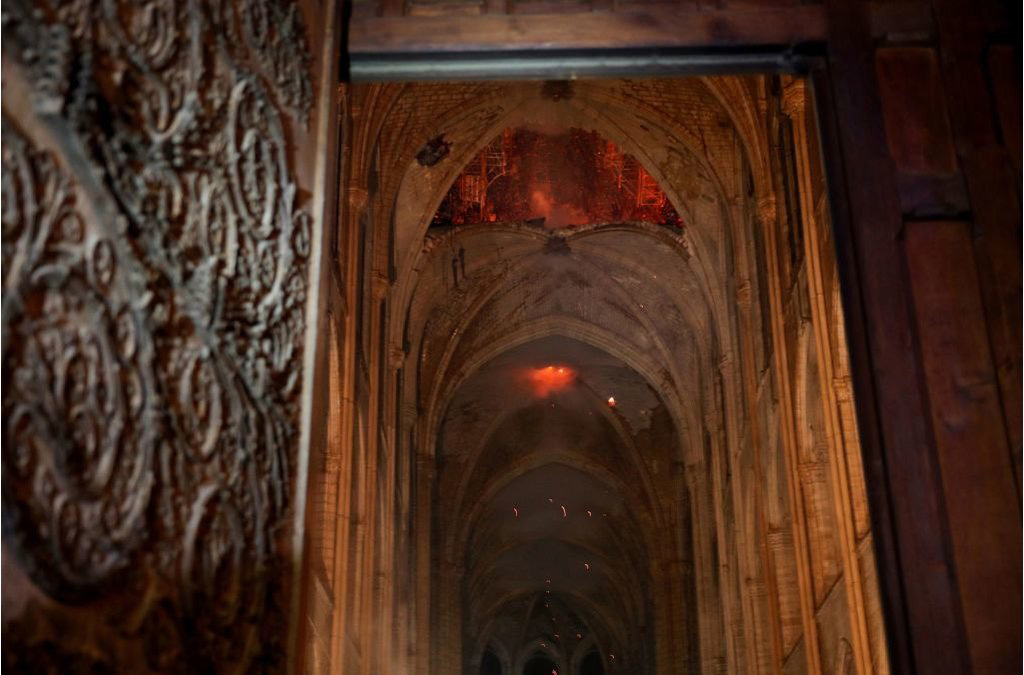重修巴黎圣母院難度有多大,?同樣木料在歐洲已近絕跡
|
上周一,,巴黎圣母院的塔樓燃起了熊熊大火。大約400名消防員趕到現(xiàn)場,,努力挽救這座在歐洲歷史和建筑史上具有重大象征意義的建筑,。 這場大火持續(xù)了12個小時,建于公元13世紀的塔樓被燒毀,。目前起火的原因仍未查明,。巴黎警方稱,大火在上周二早上已經(jīng)熄滅,,并指出巴黎圣母院的石質(zhì)結(jié)構(gòu)仍然完好,。 正如法國總統(tǒng)埃馬紐埃爾·馬克龍在上周一晚上所說的那樣,盡管“已經(jīng)避免了最壞的情況”,,不過從有關(guān)報道來看,,這場大火帶來的損失仍然是極為沉重的。從媒體報道來看,,巴黎圣母院的尖頂及支撐它的框架都被燒毀,。馬克龍雖然表示要修復巴黎圣母院,但要重建這座擁有856年歷史的宏偉教堂,,面臨的困難還是不小的?,F(xiàn)在,巴黎圣母院原有的橡木框架燒毀殆盡,,同時歐洲的古老森林也在日益萎縮,,已經(jīng)很難找到修建巴黎圣母院時使用的同樣的木料了。 |
As flames erupted in the attic of Paris’s Notre Dame Cathedral on last Monday, some 400 firefighters rushed to save one of Europe’s great historical and architectural symbols. The blaze, the cause of which remains unknown, raged for 12 hours, toppling Notre Dame’s 13th Century center spire in the process. The Paris Police Force deemed it extinguished on last Tuesday morning, noting that the stone structure of the cathedral had been saved. Even though “the worst has been avoided,” as President Emmanuel Macron said last Monday night, early reports of the damage are devastating. They indicate that the cathedral’s roof and the frame that supports it are gone. That will pose a particular challenge to efforts to rebuild the 856-year-old church, which Macron has vowed to do. As the oak frame met its end, so too did remnants of Europe’s dwindling ancient forests. |

|
用于修建巴黎圣母院的木料最早是在1160年至1170年間砍伐的。在砍伐時,,有些木料的樹齡估計已經(jīng)有三四百年之久,。其中最古老的一截木料估計已經(jīng)有1300歲的高齡。 環(huán)保組織 “帕特里莫基金會”( Fondation du Patrimoine)的副主席貝特朗·德·費多表示,,要想找到與原始橡木結(jié)構(gòu)大體差不多的木料,,幾乎是一個不可能完成的任務。他對美聯(lián)社表示,,修建巴黎圣母院所用的木料都來自于基本上未經(jīng)人類活動破壞的原始森林,。他認為,現(xiàn)在那些巨大的樹木和原始森林一樣,,已經(jīng)不復存在了,。 巴黎圣母院的官網(wǎng)指出,早在12世紀,,也就是巴黎圣母院剛剛修建的時候,,人類活動已經(jīng)成了影響法國森林覆蓋率的重要因素。隨著城市化和大規(guī)模開荒的進行,,當時的法國已經(jīng)很難找到適合巴黎圣母院使用的巨大樹木了,。 自那時以來,人類活動對原始森林的影響變得愈加明顯,。 根據(jù)去年5月發(fā)表的一項研究,歐洲僅有4%的林地是原始森林,。在俄羅斯和北歐以外的歐洲,,原始森林的面積不超過500平方公里。 該研究的第一作者,、德國生物多樣性綜合研究中心的研究員弗朗西斯科·瑪利亞·薩巴蒂尼博士表示,,盡管法國大陸近三分之一的地區(qū)都被森林覆蓋,但只有0.01%的森林沒有被砍伐,,其中有些樹木的樹齡可能在200到400歲之間,。 他表示:“保存至今的原始森林的面積很小,也很脆弱,,而且對于生物多樣性來說十分珍貴,。由于地理位置偏僻或歷史原因,它們在密集的砍伐活動中幸存了下來,,成了一個個‘珍珠’或‘孤島’,。” 根據(jù)美聯(lián)社的翻譯,,德·費多似乎將一棵樹的大小與原始森林的原始程度聯(lián)系了起來,。對此,,薩巴蒂尼表示,這種說法未必是正確的,,對于那些樹齡達幾百年的古樹,,并不一定最大的就是最古老的。光用眼睛看,,是很難分辨出一棵100歲的樹和一棵400歲的樹誰更古老的,。 他表示:“樹的大小和年齡幾乎沒有什么關(guān)聯(lián)?!?/p> 德·費多的帕特里莫基金會并未及時回復《財富》雜志的評論請求,。 目前,對歐洲原始森林的砍伐不禁沒有停止,,在一些地區(qū)反而還有愈演愈烈之勢,。大片的原始森林基本只存在于北歐和東歐的偏遠地區(qū)。近年來,,隨著市場對木材的需求上升,,木材價格也是水漲船高,這也鼓勵了一些偏遠地區(qū)的砍伐活動,,其中有的甚至是非法砍伐,。 最終,無論是從原始森林,,還是從別的地方,,要想找到早于法國中世紀的樹木作為木料,基本上是不可能的,。 薩巴蒂尼表示:“從最后的原始森林中選用木料,,意味著也會失去這些古樹。而且原始森林的損失,,也并不能彌補失去巴黎圣母院的損失,。它只是兩場悲劇的疊加?!?/p> 德·費多也得出了同樣的結(jié)論,。他表示,巴黎圣母院必須依賴新技術(shù)進行重建,。(財富中文網(wǎng)) 譯者:樸成奎 |
The wood for the soaring cathedral was first felled around 1160 to 1170, with some of it coming from trees thought to be 300 to 400 years old at the time they were chopped. That puts the oldest timber in the cathedral at nearly 1,300 years old. Replacing those beams with comparable oak is simply not an option, said Bertrand de Feydeau, vice president of the preservation group Fondation du Patrimoine. Trees that supplied the roof’s frame came from primary forests—forests that are largely untouched by human activity, he said, according to the AP. He surmised that the huge trees associated with primary forests are gone too. Notre Dame’s official website notes that even in the 12th century, when the cathedral was being built, human activity was already a concern for French forests, with urbanization and land clearing making it difficult to source wood large enough for the design of the cathedral. Since then, the impact of human activity on primary forests has only become more pronounced. Only 4% of Europe’s remaining woodland is primary forest, according to a study published last May, with none larger than 500 square kilometers outside of Russia or Northern Europe. While forest covers nearly a third of mainland France, just 0.01% of it is untouched, containing trees around 200 to 400 years old, said Dr. Francesco Maria Sabatini, a lead author on the study and a researcher at the German Centre for Integrative Biodiversity Research. “Primary forests are small, fragile and precious for biodiversity,” he said. “They represent ‘pearls’ or ‘islands’ that survived intensive logging thanks to their remoteness or historical accidents.” Based on the AP’s translation, de Feydeau associated a tree’s size with its primary forest origin. That’s not necessarily accurate, Sabatini said; the oldest trees aren’t always the largest ones when we’re measuring a tree’s age in centuries. It’s borderline impossible to visually tell the difference between a living tree 100 years old and one that’s 400 years old, he said. “There is very little correlation between size and age,” he said. De Feydeau’s Fondation du Patrimoine did not return Fortune‘s request for comment. Nonetheless, logging of Europe’s ancient forests has not only continued but increased in some areas. Large forests of that kind only exist in remote regions in northern and Eastern Europe, where rising demand for timber has pushed up prices and encouraged logging in more distant areas, with some of it being done illegally. Ultimately, there is simply no way to replace wood that predates the founding of even medieval France—from ancient forests or otherwise. “Extracting timber from the last primary remnants means losing also these, and this loss won’t cover up the tragedy of losing Notre Dame,” said Sabatini. “It will simply add up.” De Feydeau seemed to come to this conclusion too: Notre Dame, he said, will have to rely on new technologies to rebuild. |













